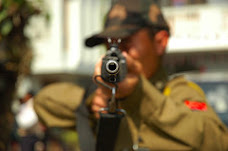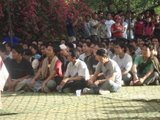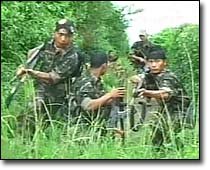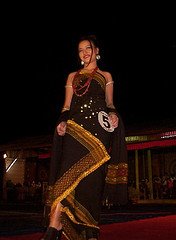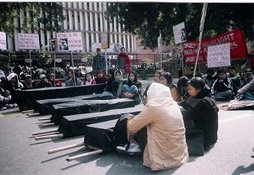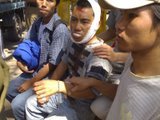
There is it group of people who have never been able to find out their nomenclature by which they can collectively identify themselves as an ethnic group।
Prior to 1937 these people lived in Indo-Burma। However, in 1937 Burma was separated from India and the people living in Chin-hills and upper Chindwin have gone to Burma। Again in 1971 Chittagong Hill Tracts have gone to Bangladesh।
Thus, these people have been scattered into three different Independent countries creating a lot of predicaments for communications and personal contacts from one country to another. Gradually some of these ethnic groups lost their identity and tend to identify themselves with their neighbouring group who influenced them either politically or through their religious and social activities.
A bulk of their population is found in the Chin State of Burma while other members are dispersing in Manipur, Tripura, Bangladesh, Assam and Mizoram.
The tribes found in some parts of North-East India like Manipur. Tripura were called Kuki by the Enling their cognate tribes found in Burma were called Chin and those found in Mizoram, Assam, Bangladesh and Bengal were called Lushai. So, they became Kuki, Chin and Lushai. However the different tribes or clans inhabiting the entire perimeter of the present Mizoram have completely succeeded in disowning the term Kuki, Chin and Lushai and have adopted an inborn word Zomi commonly known as Mizo.
These ethnic groups were given various names by the people with whom they are living together by observing their demeanor and way of living. No common name exist till to-day which can comprise all these Kuki-Chin Tribes, mainly due to lack of centralized authority-an authority that could unify and integrate all the group into a well knit nation.
These group of people are not eager in forming a sub-nation. Instead, they prefer to be identified individually by the name of their specific tribes. These ethnics are divided into clans। Most of the tribes are now Christian.
Before they were imbued with Christian faith, they were worshipping various spirits, the spirit dwelling in different places like the precipice, water, woods rocks etc. About 95% of the Chin-Kuki-Mizo have now professed Christianity. They have therefore discarded many of their customs and tradition.
Yet, they still retain the majority of their customs and practices which are not contradictory to their new faith. These Chin-Kuki-Mizo people loved social intercourse and bustles, and accordingly. Kut is a common feature of their social life but not because of its pomposity, merriment and gaiety of the celebration, but because of its religious aspects. Kut is a festival, primarily to remember the creator God and to give thanks to him for his abundant blessings.
One of their cultural heritages which they eagerly looked forward to is Kuts because all sections of people whether rich or poor enjoyed themselves on such occasions forgetting all their anxieties and worries. There were three kinds of Kuts, though their exact origin were lost in oblivion. They are, Mim Kut, Pawal Kut, and Chapchar or Chapphou Kut. Mim Kut : Mim Kut was said to be the oldest of the three.
It derived its name form a plant called Mim the grain of which is eaten. This Mim Kut was held in honour of the dead and was also known as "Thitin" meaning "Departure of the dead spirit". The Chin-Kuki-Mizo people believed that the spirit of the dead frequented its home for 3 Lunar months immediately after death.
The origin of Mim Kut is connected with a couple who fell in love and got married. But soon after the wife died. The husband lacked sufficient emotional, Psychological or spiritual resources for bearing the trauma of the sudden death of his beloved wife and wept and wept. One day while weeping he fell into a state of trance and said to have visited "Mithikho", where he met his beloved wife but found her famished. When the husband enquired about the reason she replied that she could not procure enough food to eat, and implored her husband to go back and collect maize, cucumber, vegetable etc., from the Jhum and make offering to her so that she might get foods to eat to her satisfaction.
The husband did everything as told. After some months the husband was again in a state of trance. This time he saw his wife fat and stout. When he asked the reason his wife told him that she became stout and lovely because of the offerings he made for her. After recovering from his trance, he told his friends all what had happened in his trance. It is said that from that time onwards offerings to the dead became a common practice.
During Mim Kut, fresh vegetables, maize and bread prepared from sticky rice (Changman) were offered to the spirit of the dead persons of their respective families. This kut was also known as "feast of weeping". Normally it lasted for three days during which "Zu" country made liquor were served and songs were sung. Mim Kut is usually observed at the time of germination of maize, millet, cucumber and other green vegetables so as to celebrate the coming of fresh and vegetables.
Pawl Kut: Pawl means "Straw" hence pawl kut means kut held soon after the harvest. Some people hod the view that it originated with the catching of pawl Zu or Zu pawl (rats) found in heap of straw. Others connect it to the famine which visited them for three consecutive years. When they were in the Kabaw Vallley (Myanmar) on the fourth year, when they were relieved of the disaster their chief suggested to his Upas (village elders) that they should prepare a public feast, in which all the people might enjoy meal to their heart's content. This was agreed and public feast was arranged by killing fowls, pigs and goats.
Thus, the pawl kut came into existence. Chapchar Kut : Chapchar Kut is a festival observed in the intervening period between the felling of trees for Jhum and the burning of Jhum. The Chin-Kuki-Mizo people usually went for hunting to celebrate the occasion. While the Chief and Upas engaged themselves in preparing Zu to last the feast.
Every family of the Chin-Kuki-Mizo also prepared Zu to cover the whole feast which usually lasted for about a week. The Chapphou or Chapchar Kut was usually held in the jhum field. The felling of trees and bamboos for jhum cultivations were normally carried out during the month of January every year and left for drying to be burnt subsequently in the month of March of the year. Drinking feasting, dancing etc are usually performed during the short leisure period available to them.
The three kuts however today cannot be celebrated in its own due season due to the change of time, belief and style of the social life of the people. Thus the three kuts had been merged into one called Chavang Kut (Autumn festival) for the sake of convenience, which is celebrated on 1st November every year. The Chavang Kut is the only traditional institutions which bring together all the different tribes of the Chin-Kuki-Mizo on a single platform in a most harmonious environment.
It is one of the festivals identified by the Central Government and it has introduced a new elements of going with the modem times. Attractive items like Fashion Show. Beauty contests have been added. The Chavang Kut has now assumed not only a regional significance but also an international significance in the sense that its impact is no more confined to the state alone. Kut is a pride for the Chin-Kuki-Mizo and is a means through which the outside World could identify who they are.
It should also be on the anvil of the organisers to make attempts to bring outside journalists as well as TV, Net Works like Zee TV so that wide publicity is given to Kut and that the rich cultural heritages of the Chin-Kuki-Mizo tribe could be exposed.
Sominthang Doungel wrote this article for The Sangai Express . This article was webcasted on November 17th, 2006




